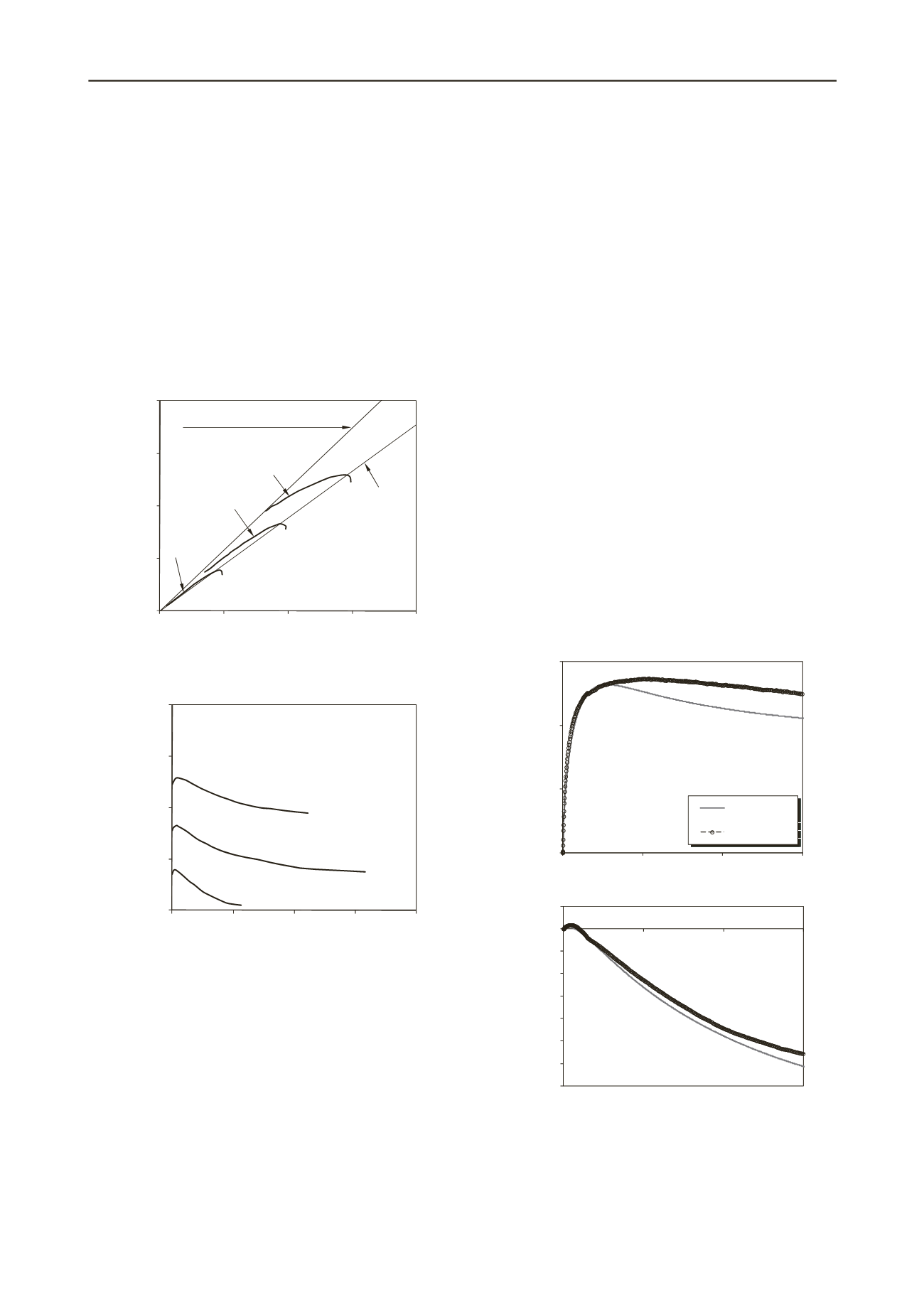
835
Technical Committee 103 /
Comité technique 103
shown in Figure 2(a). Its slope in the deviatoric stress invariant
(q) versus mean effective stress (p
) plane is M
pcs
= 1.16,
corresponding to a friction angle of 36.0° It can be seen from
Figure 2(b) that strain softening occurred in all the tests.
Therefore, using the same definition as for the triaxial tests, the
instability line for plane-strain conditions can be drawn through
the peak points of the undrained effective stress paths, as shown
in Figure 2(a). Similar to the triaxial CSL
tc
(see Figure 1a), the
value M
psc
under plane-strain conditions does not appear
affected by stress level within a narrow stress range. It can also
be seen from Figure 2(a) that all the effective stress paths
approach the CSL
psc
. Therefore, the CSL
psc
can be considered
the same as the SSL, as established earlier in Figure 1(a) for
axisymmetric conditions (Wanatowski and Chu 2007, 2008).
0
100
200
300
400
0
100
200
300
400
Deviatoric stress invariant, q (kPa)
Mean effective stress, p' (kPa)
U04
CSL
psc
(
psc
= 1.16)
(
from CK
0
D plane-strain tests)
U06
U05
Instability Line
Instability
Zone
(a)
0
100
200
300
400
0
5
10
15
20
Deviatoric stress invariant, q (kPa)
Major principal strain,
(%)
U05, e
0
= 0.915 (p
c
' = 198 kPa)
U04, e
0
= 0.935 (p
c
' = 97 kPa)
U06, e
0
= 0.899 (p
c
' = 298 kPa)
(b)
Figure 2. Results of CK
0
U plane-strain tests on loose Changi sand.
3 NUMERICAL MODELLING
3.1
NorSand model
NorSand is an isotropically hardening-isotropically softening
critical state model that captures a wide range of particulate soil
behaviour. It has two particular features, both controlled by the
state parameter (
): i) accurate representation of dilatant soils
using an internal cap to the yield surface (the locus of this cap is
the “Hvorslev” surface); and, ii) the yield surface generally does
not intersect the critical state, but only moves to that condition
with shear strain. The NorSand parameter set is common to
other critical state models, but with the addition of a plastic
hardening modulus (
‘H’
, required because the yield surface is
decoupled from the critical state) and a dilatancy parameter (
)
which scales the dilation rate to
. Cam Clay (Schofield and
Wroth, 1968) is a “special” case of NorSand requiring particular
choice of plastic hardening modulus and initial state. Originally
derived for triaxial compression (Jefferies 1993), NorSand was
extended for 3D stress states by Jefferies and Shuttle (2002);
there have been further minor revisions to capture the evolution
of the critical friction ratio with strain (Jefferies and Shuttle
2005).
3.2
Calibration
All of the eight NorSand parameters for Changi sand were
determined from standard triaxial tests following the procedures
reported in Jefferies and Shuttle (2005). The NorSand CSL was
determined from loose CID triaxial tests. All other parameters
were determined from dense CID triaxial tests. As a single
NorSand parameter set is applicable to the full range of
densities and initial states, the calibration involves obtaining a
reasonable fit to all drained tests (rather than the best fit a
particular test). A typical fit is shown in Figure 3 for test CD04
(p
0
= 150 kPa, e
0
= 0.654); as seen here, the fits to the
volumetric strain evolution is usually excellent as is the shear
stiffness to peak strength, but the post-peak strength tends to
exceed that measured (a presumed consequence of the test data
being determined from overall deformation of the whole
sample). For Changi Sand, the parameter set is:
M
tc
= 1.35,
= 0.75 at 1 kPa,
10
= 0.106, N= 0.5,
= 4.4,
H
= 124-880
,
G/p
0
= 200 to 700,
=0.2.
0
200
400
600
0
5
10
Deviatoric stress invariant, q (kPa)
Major principal strain,
1
(%)
15
NorSand
Changi Sand
-7
-6
-5
-4
-3
-2
-1
0
1
Volumetric strain,
v
( %)
Figure 3. Calibration of NorSand for Changi sand to triaxial test CD04
(H= 280, G/p
0
= 700).
3.3
Validation
NorSand was validated in plane strain by using the parameter
set from the triaxial calibration (above) to predict the behaviour
of very loose undrained plane strain tests. The fit to CK
0
U plane


